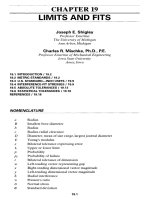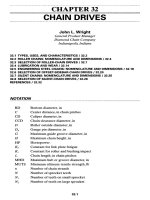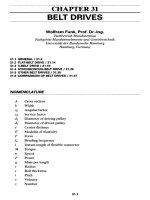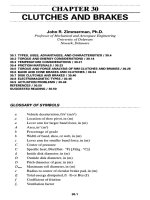Tài liệu Handbook of Machine Design P32 pdf
Bạn đang xem bản rút gọn của tài liệu. Xem và tải ngay bản đầy đủ của tài liệu tại đây (733.68 KB, 17 trang )
CHAPTER
27
ROLLING-CONTACT
BEARINGS
Charles
R.
Mischke,
Ph.D.,
RE.
Professor
Emeritus
of
Mechanical
Engineering
Iowa
State
University
Ames,
Iowa
21A
INTRODUCTION
/
27.2
27.2 LOAD-LIFE RELATION
FOR
CONSTANT RELIABILITY
/
27.7
27.3 SURVIVAL RELATION
AT
STEADY LOAD
/
27.8
27.4 RELATING
LOAD,
LIFE,
AND
RELIABILITY GOAL
/
27.9
27.5 COMBINED RADIAL
AND
THRUST LOADINGS
/
27.12
27.6 APPLICATION FACTORS
/
27.13
27.7 VARIABLE LOADING
/
27.13
27.8
MISALIGNMENT
/
27.16
REFERENCES
/
27.17
GLOSSARY
OF
SYMBOLS
a
Exponents;
a
=
3 for
ball bearings;
a =
10
A
for
roller bearings
AF
Application
factor
b
Weibull shape parameter
C
5
Static load rating
C
10
Basic load rating
or
basic dynamic load rating
/
Fraction
F
Load
F
a
Axial load
F
eq
Equivalent radial load
F
1
/th
equivalent radial load
F
r
Radial load
/
Integral
L
Life measure,
r or h
L
D
Desired
or
design
life
measure
L
R
Rating
life
measure
L
10
Life
measure exceeded
by 90
percent
of
bearings tested
FIGURE
27.1 Photograph
of a
deep-groove preci-
sion
ball bearing
with
metal two-piece cage
and
dual
seals
to
illustrate
rolling-bearing
terminology. (The
Bar
den
Corporation.)
n
Design factor
n
D
Desired
or
design rotative speed,
r/min
HI
Application
or
design factor
at
/th
level
n
R
Rating rotative speed, r/min
R
Reliability
V
Rotation factor; inner ring rotations,
V=I;
outer ring,
V =
1.20
x
Life measure
in
Weibull survival equation
Jc
0
Weibull guaranteed
life
parameter
X
Radial factor
for
equivalent load prediction
Y
Thrust factor
for
equivalent load prediction
0
Weibull characteristic
life
parameter, rotation angle
$
Period
of
cyclic variation,
rad
27.7 INTRODUCTION
Figures 27.1
to
27.12 illustrate something
of the
terminology
and the
wide variety
of
rolling-contact bearings available
to the
designer. Catalogs
and
engineering manuals
can
be
obtained
from
bearing manufacturers,
and
these
are
very comprehensive
and
of
excellent quality.
In
addition, most manufacturers
are
anxious
to
advise designers
on
specific applications.
For
this reason
the
material
in
this chapter
is
concerned
mostly
with providing
the
designer
an
independent viewpoint.
FIGURE
27.3
Rolling bearing with spherical
rolling elements
to
permit misalignment
up to
±3°
with
an
unsealed design.
The
sealed bearing,
shown
above, permits misalignment
to
±2°.
(McGiIl
Manufacturing
Company,
Inc.)
FIGURE
27.4
A
heavy-duty cage-guided
nee-
dle
roller bearing with machined race. Note
the
absence
of an
inner ring,
but
standard inner
rings
can be
obtained.
(McGiIl
Manufacturing
Company,
Inc.)
FIGURE
27.2
Photograph
of a
precision ball bearing
of the
type generally
used
in
machine-tool applications
to
illustrate terminology.
(Bearings
Divi-
sion,
TRW
Industrial Products Group.)
FIGURE
27.5
A
spherical roller bearing with
two
rows
of
rollers running
on a
common sphered race-
way.
These bearings
are
self-aligning
to
permit mis-
alignment resulting
from
either mounting
or
shaft
deflection under load.
(SKF
Industries,
Inc.)
FIGURE
27.7 Ball thrust bearing. (The Tor-
rington
Company.)
FIGURE
27.6 Shielded, flanged, deep-groove
ball bearing. Shields serve
as
dirt barriers;
flange
facilitates
mounting
the
bearing
in a
through-
bored hole. (The Barden Corporation.)
FIGURE
27.8 Spherical roller thrust bearing.
(The
Torrington Company.)
FIGURE 27.9 Tapered-roller thrust bearing.
(The
Torrington
Company.)
FIGURE 27.10 Tapered-roller bearing;
for
axial loads, thrust loads,
or
combined axial
and
thrust loads.
(The
Timken Company.)
FIGURE 27.12
Force
analysis
of a
Timken bearing.
(The
Timken Company.)
FIGURE 27.11 Basic principle
of a
tapered-roller bearing with
nomenclature.
(The
Timken Company.)
Rolling-contact bearings
use
balls
and
rollers
to
exploit
the
small
coefficients
of
friction
when hard bodies roll
on
each
other.
The
balls
and
rollers
are
kept separated
and
equally spaced
by a
separator (cage,
or
retainer). This device, which
is
essential
to
proper bearing functioning,
is
responsible
for
additional friction. Table 27.1 gives
friction
coefficients
for
several types
of
bearings
[27.1].
Consult
a
manufacturer's
catalog
for
equations
for
estimating friction torque
as a
function
of
bearing mean
diameter, load, basic load rating,
and
lubrication detail.
See
also Chap.
25.
Permissible speeds
are
influenced
by
bearing size, properties, lubrication detail,
and
operating temperatures.
The
speed varies inversely with mean bearing diameter.
For
additional details, consult
any
manufacturer's catalog.
Some
of the
guidelines
for
selecting bearings, which
are
valid more
often
than
not,
are as
follows:
•
Ball bearings
are the
less expensive choice
in the
smaller sizes
and
under lighter
loads,
whereas roller bearings
are
less expensive
for
larger sizes
and
heavier loads.
•
Roller bearings
are
more satisfactory under shock
or
impact loading than ball
bearings.
•
Ball-thrust bearings
are for
pure thrust loading only.
At
high speeds
a
deep-
groove
or
angular-contact ball bearing usually will
be a
better choice, even
for
pure thrust loads.
•
Self-aligning ball bearings
and
cylindrical roller bearings have very
low
friction
coefficients.
•
Deep-groove ball bearings
are
available with seals built into
the
bearing
so
that
the
bearing
can be
prelubricated
to
operate
for
long periods without attention.
•
Although rolling-contact bearings
are
"standardized"
and
easily selected
from
vendor
catalogs, there
are
instances
of
cooperative development
by
customer
and
vendor
involving special materials, hollow elements, distorted raceways,
and
novel
applications.
Consult your bearing specialist.
It is
possible
to
obtain
an
estimate
of the
basic static load rating
C
s
.
For
ball
bearings,
C
s
=
Mn
b
dl
(27.1)
For
roller bearings,
C
s
=
Mn
r
l
e
d
(27.2)
TABLE
27.1
Coefficients
of
Friction
Bearing type
Self-aligning
ball
Cylindrical
roller
with
flange-guided
short rollers
Ball
thrust
Single-row
ball
Spherical
roller
Tapered
roller
SOURCE:
Ref.
[27.1].
Coefficient
of
friction
n
0.0010
0.0011
0.0013
0.0015
0.0018
0.0018
where
C
5
=
basic static loading rating, pounds
(Ib)
[kilonewtons (kN)]
n
b
=
number
of
balls
n
r
=
number
of
rollers
d
b
=
ball diameter, inches
(in)
[millimeters
(mm)]
d
=
roller diameter,
in
(mm)
l
e
=
length
of
single-roller contact line,
in
(mm)
Values
of the
constant
M are
listed
in
Table 27.2.
TABLE
27.2
Value
of
Constant
M for Use in
Eqs.
(27.1)
and
(27.2)
Constant
M
Type
of
bearing
C
5
,
Ib
C
5
,
kN
Radial ball 1.78
X
10
3
5.11
X
10
3
Ball
thrust
7.10
X
10
3
20.4
X
10
3
Radial
roller
3.13
X
10
3
8.99
X
10
3
Roller thrust 14.2
X
10
3
40.7
X
IQ
3
27.2
LOAD-LIFE
RELATION
FOR
CONSTANT
RELIABILITY
When
proper attention
is
paid
to a
rolling-contact bearing
so
that
fatigue
of the
material
is the
only cause
of
failure,
then nominally identical bearings exhibit
a
reli-
ability-life-measure
curve,
as
depicted
in
Fig.
27.13.
The
rating
life
is
defined
as the
life
measure (revolutions, hours, etc.) which
90
percent
of the
bearings
will
equal
or
exceed.
This
is
also
called
the
L
10
life
or the
,B
10
life.
When
the
radial
load
is
adjusted
so
that
the
Li
0
life
is 1 000 000
revolutions (r), that load
is
called
the
basic
load
rating
C
(SKF
Industries, Inc.).
The
Timken Company rates
its
bearings
at 90 000
000.
Whatever
the
rating basis,
the
life
L can be
normalized
by
dividing
by the
rating
life
Li
0
.
The
median
life
is the
life
measure equaled
or
exceeded
by
half
of the
bearings.
Median
life
is
roughly
5
times rating
life.
For
steady radial loading,
the
life
at
which
the
first
tangible evidence
of
surface
fatigue
occurs
can be
predicted
from
F
0
L
=
constant (27.3)
where
a = 3 for
ball bearings
and a =
10
A
for
cylindrical
and
tapered-roller bearings.
At
constant reliability,
the
load
and
life
at
condition
1 can be
related
to the
load
and
life
at
condition
2 by Eq.
(27.3). Thus
FfL
1
=
FfL
2
(27.4)
If
FI
is the
basic load rating
Ci
0
,
then
LI
is the
rating
life
L
10
,
and so
/
7
\l/«
Cio=
yH
(F)
(27.5)
\LIO/
RELIABILITY
R
FIGURE 27.13 Survival function representing
endurance
tests
on
rolling-contact bearings
from
data accumulated
by SKF
Industries, Inc.
(From
Ref.[27.2J.)
If
L
R
is in
hours
and
n
R
is in
revolutions
per
minute, then
L
10
=
60L
R
n
R
.
It
follows
that
C
10
=
W^Y'"
(27.6)
\L
R
n
R
I
where
the
subscript
D
refers
to
desired
(or
design)
and the
subscript
R
refers
to
rat-
ing
conditions.
27.3 SURVIVAL RELATION
AT
STEADY LOAD
Figure 27.14 shows
how
reliability varies
as the
loading
is
modified
[27.2].
Equation
(27.5) allows
the
ordinate
to be
expressed
as
either
F/C
W
or
L/L
W
.
Figure 27.14
is
based
on
more than 2500
SKF
bearings.
If
Figs. 27.13
and
27.14
are
scaled
for
recov-
ery of
coordinates, then
the
reliability
can be
tabulated together
with
L/L
W
.
Machin-
ery
applications
use
reliabilities exceeding 0.94.
An
excellent curve
fit can be
realized
by
using
the
three-parameter Weibull distribution (see Table
2.2 and
Sec.
2.6).
For
this distribution
the
reliability
can be
expressed
as
[
/V
V
\*>1
-(HS)]
(2
">
where
x =
life
measure,
Jt
0
=
Weibull guaranteed
life
measure,
0 =
Weibull character-
istic
life
measure,
and b =
Weibull shape factor. Using
the 18
points
in
Table 27.3 with
Jc
0
=
0.02,6
=
4.459,
and b =
1.483,
we see
that
Eq.
(27.7)
can be
particularized
as
—[fs^n
BEARING
FATIGUE
LIFE
L/L
1Q
FRACTION
OF
BEARING RATING
LIFE
L/l_
10
FIGURE
27.14
Survival
function
at
higher reliabilities based
on
more than 2500
endurance
tests
by SKF
Industries, Inc.
(From
Ref.
[27,2],)
The
three-parameter
Weibull
constants
are 0 =
4.459,
b
-1.483,
and
Jc
0
=
0.02 when
x -
L/L
10
=
Ln/(L
R
n
R
).
For
example,
for
L/L
W
=
0.1,
Eq.
(27.8) predicts
R =
0.9974.
27.4 RELATING
LOAD,
LIfE
9
AND
RELIABILITY
GOAL
If
Eq.
(27.3)
is
plotted
on
log-log coordinates, Fig.
27.15
results.
The FL
loci
are
rec-
tified,
while
the
parallel loci exhibit
different
reliabilities.
The
coordinates
of
point
A
are the
rating
life
and the
basic load rating. Point
D
represents
the
desired
(or
design)
life
and the
corresponding load.
A
common problem
is to
select
a
bearing
which
will
provide
a
life
L
D
while carrying load
F
D
and
exhibit
a
reliability
R
D
.
Along
line
BD,
constant reliability prevails,
and Eq.
(27.4) applies:
TABLE
27.3 Survival
Equation
Points
at
Higher
Reliabilities
1
Reliability
R
Life
measure
L/L
10
Reliability
R
Life
measure
L/L\
Q
0.94 0.67 0.994 0.17
0.95 0.60
0.995
0.15
0.96 0.52 0.996 0.13
0.97
0.435
0.997 0.11
0.975
0.395
0.9975
0.095
0.98 0.35 0.998 0.08
0.985
0.29 0.9985 0.07
0.99 0.23 0.999 0.06
0.992
0.20
0.9995
0.05
fScaled
from
Ref.
[27.2],
Fig.
2.
PROBABILITY
OF
FAILURE,
F, %
NORMALIZED BEARING LIFE
x
=
L/L
1Q
=
(L
0
n
Q
)/(L
R
n
R
)
FIGURE
27.15
Reliability
contours
on a
load-life
plot
useful
for
relating
catalog
entry,
point
A, to
design
goal,
point
D.
/r
\
1/fl
Fs
=
F
0
(^]
(27.9)
\
X
B
/
Along line
AB the
reliability changes,
but the
load
is
constant
and Eq.
(27.7)
applies.
Thus
[
/v_v
\b~\
№)]
(27
-
io)
Now
solve
this equation
for x and
particularize
it for
point
B,
noting that
R
D
=
R
B
.
I
1
\
llb
X
8
=
X
0
+
(0-JC
0
)
In—
(27.11)
V
K
D
/
Substituting
Eq.
(27.11)
into
Eq.
(27.9)
yields
^
=
c
'°-4o
+
(e-Jpn(i/^)rr
(2712)
For
reliabilities greater than 0.90, which
is the
usual case,
In
(l/R)
=
1 - R and Eq.
(27.12)
simplifies
as
follows:
^=4**(e-5(i-*)»r
(2713)
The
desired
life
measure
X
D
can be
expressed most conveniently
in
millions
of
revo-
lutions
(for SKF).
Example
/. If a
ball bearing must carry
a
load
of 800
Ib
for 50 x
10
6
and
exhibit
a
reliability
of
0.99, then
the
basic load rating should equal
or
exceed
BEARING
LOAD
F
r
oj
50
-p*
10
[
0.02
+
(4.439)(1
-
0.99)
m
483
J
-
4890
Ib
This
is the
same
as
21.80
kN,
which corresponds
to the
capability
of a 02
series
35-
mm-bore
ball bearing. Since selected bearings have
different
basic load ratings
from
those required,
a
solution
to Eq.
(27.13)
for
reliability extant
after
specification
is
useful:
J
*
D
-*#UF
D
Y
f
L
(e-Jb)(C
10
Hy
J
(2A14)
Example
2. If the
bearing selected
for
Example
1, a 02
series 50-mm bore,
has a
basic
load rating
of
26.9
kN,
what
is the
expected reliability?
And
Ci
0
=
26.9
x
10
3
)/445
-
6045
Ib.
So
[50-0.02(6045/80O)
3
I
1483
^
=
1
4(4.439X6045/800)3
J
=
0
'"
66
The
previous equations
can be
adjusted
to a
two-parameter Weibull survival
equation
by
setting
#
0
to
zero
and
using appropriate values
of 0 and
b.
For
bearings
rated
at a
particular speed
and
time, substitute
L
D
n
D
/(L
R
nR)
for
X
D
.
The
survival relationship
for
Timken tapered-roller bearings
is
shown graphically
in
Fig. 27.16,
and
points scaled
from
this curve
form
the
basis
for
Table 27.4.
The
sur-
vival
equation turns
out to be the
two-parameter Weibull relation:
[
/ v
\b~\
r
fill
\
1.4335"!
-(DHKiIi?)
]
<
2
™>
FRACTION
OF
RATED LIFE
L/L
1Q
FIGURE 27.16 Survival
function
at
higher reliabilities based
on
the
Timken Company
tapered-roller
bearings.
The
curve
fit is a
two-
parameter Weibull function with constants
6 =
4.48
and b -
3
A
(x
0
=
O)
when
x =
Lnl(L
R
n
R
).
(From
Ref.
[27.3].)
RELIABILITY
TABLE
27.4
Survival
Equation Points
for
Tapered-Roller
Bearings
1
Reliability
R
Life
measure
L/L
i0
Reliability
R
Life
measure
LfL
10
0.90
1.00 0.96 0.53
0.91
0.92 0.97 0.43
0.92
0.86 0.98
0.325
0.93
0.78 0.99 0.20
0.94
0.70
0.995
0.13
0.95
0.62
0.999
0.04
f
Scaled
from
Fig.
4 of
Engineering Journal,
Sec.
1, The
Timken
Company, Canton,
Ohio,
rev. 1978.
The
equation corresponding
to Eq.
(27.13)
is
c r \
XD
I"*
Cw
-
FD
[Q(i-Rr\
=
F
D
(^\\l-R)-^
(27.16)
V
H
/
And
the
equation corresponding
to Eq.
(27.14)
is
(
Y
W C
\-
ab
t)(t)
<
27
-">
Example
3. A
Timken tapered-roller bearing
is to be
selected
to
carry
a
radial load
of
4
kN
and
have
a
reliability
of
0.99
at
1200 hours
(h) and a
speed
of 600
revolutions
per
minute
(r/min).
Thus
L
D
n
D
1200(600)
XD
L^-SOOO(SOO)-
0
'
480
and
[
O
48
1
3/1
°
4.48^0.99V"]
=5M1N
Timken
bearings
are
rated
in
U.S. Customary System (USCS) units
or in
newtons;
therefore,
a
basic load rating
of
5141
N or
higher
is to be
sought.
For any
bearings
to be
specified, check with
the
manufacturer's engineering man-
ual for
survival equation information. This
is
usually
in the
form
of
graphs,
nomo-
grams,
or
equations
of
available candidates. Check with
the
manufacturer
on
cost
because production runs materially
affect
bearing cost.
27.5
COMBlNEDRADIALANDTHRUST
LOADINGS
Ball
bearings
can
resist some thrust loading simultaneously with
a
radial load.
The
equivalent radial load
is the
constant pure radial load which
inflicts
the
same dam-
age
on the
bearing
per
revolution
as the
combination.
A
common
form
for
weight-
ing the
radial load
F
r
and the
axial load
F
a
is
F
e
=VXF
r
+YF
a
(27.18)
where
F
e
=
equivalent radial load.
The
weighting factors
X and Y are
given
for
each
bearing type
in the
manufacturer's engineering manual.
The
parameter
V
distin-
guishes between inner-ring rotation,
V=I
9
and
outer-ring rotation,
V=
1.20.
A
com-
mon
form
of Eq.
(27.18)
is
F
e
=
max(VTv,
X
1
VFr
+
Y
1
F
09
X
2
VF
r
+
Y
2
F
0
, )
(27.19)
27.6
APPLICATION
FACTORS
In
machinery applications
the
peak radial loads
on a
bearing
are
different
from
the
nominal
or
average load owing
to a
variation
in
torque
or
other influences.
For a
number
of
situations
in
which
there
is a
body
of
measurement
and
experience, bear-
ing
manufacturers tabulate application
factors
that
are
used
to
multiply
the
average
load
to
properly account
for the
additional
fatigue
damage resulting
from
the
fluc-
tuations. Such factors perform
the
same
function
as a
design factor.
In
previous
equations,
F
D
is
replaced
by
nF
D
or
AF(F
0
),
where
AF is the
application factor.
27.7
VARIABLELOADING
At
constant reliability
the
current
F
a
L
product measures progress toward failure.
The
area under
the
F
1
versus
L
curve
at
failure
is an
index
to
total damage resulting
in
failure.
The
area under
the
F
a
L
locus
at any
time prior
to
failure
is an
index
to
damage
so
far.
If the
radial load
or
equivalent radial load varies during
a
revolution
or
several revolutions
in a
periodic
fashion,
then
the
equivalent radial load
is
related
to the
instantaneous radial load
by
/if*
y/«
FeH-J
F'd6
(27.20)
\q>
J
0
/
where
<|>
=
period
of the
variation—2n
for
repetition every revolution,
4n
for
repeti-
tion every second revolution,
etc. (see Fig.
27.17).
Example
4.
A
bearing load
is
given
by
F(Q)
=
1000
sin Q in
pounds
force.
Estimate
the
equivalent load
by
using Simpson's rule,
M
rn
"13/10
Feq
=
-
(1000
sin
9)
10/3
dQ
=
762
Ib
In
J
0
J
When equivalent loads
are
applied
in a
stepwise
fashion,
the
equivalent radial load
is
expressible
by
Feq^Z/ifaiFO'l
1
'"
(27.21)
L =
I
J
BEARING
ROTATION ANGLE
9
FIGURE 27.17 Equivalent radial load when load varies peri-
odically with angular position.
where
/•
=
fraction
of
revolution
at
load
F
1
n
t
=
application
or
design factor
FI
-
/th
equivalent radial load
a
=
applicable
exponent—3
for
ball bearings
and
10
A
for
roller bearings
Example
5. A
four-step loading cycle
is
applied
to a
ball bearing.
For
one-tenth
of
the
time,
the
speed
is
1000
rpm,
F
r
= 800
Ib,
and
F
a
= 400
Ib;
for
two-tenths
of the
time,
the
speed
is
1200 rpm,
F
r
=
1000
Ib,
and
F
a
= 500
Ib;
for
three-tenths
of the
time,
the
speed
is
1500 rpm,
F
r
=
1500
Ib,
and
F
a
= 700
Ib;
for
four-tenths
of the
time,
the
speed
is
800
rpm,
F
r
=
1100
Ib,
and
F
a
= 500
Ib.
For
this shallow-angle, angular-contact ball
bearing,
X
1
=
I
9
Y
1
=
1.25,
X
2
=
0.45,
Y
2
=
1.2,
and
V=I.
This loading cycle
is
also
depicted
in
Fig. 27.18.
FIGURE 27.18 Loading cycle: one-tenth
of
time
at
1000
rpm,
F
r
=
800,
F
0
=
400; two-tenths
of
time
at
1200 rpm,
F
r
=
1000,
F
a
=
500; three-tenths
of
time
at
1500 rpm,
F
r
=
1500,
F
a
=
700;
four-tenths
of
time
at 800
rpm,
F
r
=
1100,
F
a
=
500;
X
1
= 1,
Y
1
=
1.25,
X
2
=
0.45,
Y
2
=
1.2,
V=
I.
EXPONENTIATED
BEARING
RADIAL
LOAD
BEARING
EQUIVALENT RADIAL LOAD,
F
Product
(AFXF.)
1430
2031
2969
2588
Application
factor
AF
1.1
1.25
1.25
1.50
Equivalent
load
F
e
1300
1625
2375
1725
Axial
load
F
a
400
500
700
500
Radial
load
F
f
800
1000
1500
1100
Revolution
fraction/
0.090
0.216
0.405
0.288
Product
I
100
240
450
320
1110
Speed,
rpm
1000
1200
1500
800
Time
fraction
0.1
0.2
0.3
0.4
TABLE
27.5 Tabulation
for
Example
5
The
first
step
in the
solution
is to
create
Table 27.5.
The
equivalent radial load
is
F
eq
=
[0.090(143O)
3
+
0.216(2031)
3
+
0.405(2969)
3
+
0.288(2588)
3
]
1/3
=
2604
Ib
Without
the use of
design
factors,
the
equivalent radial load
is
F
eq
=
[0.090(130O)
3
+
0.216(1625)
3
+
0.405(2375)
3
+
0.288(1725)
3
]
1/3
=
2002
Ib
The
overall design
factor
is
2604/2002,
or
1.30.
If
this sequence were common
in a
machinery
application,
a
bearing manufacturer might recommend
an
application
factor
of
1.30
for
this particular application.
27.8
MISALIGNMENT
The
inner ring
of a
rolling-contact bearing
is
tightly
fitted
to the
shaft,
and the
axis
of
rotation
is
oriented,
as is the
shaft
centerline.
The
outer ring
is
held
by
some
form
of
housing,
and its
axis
is
oriented
as
demanded
by the
housing.
As the
shaft
deflects
under load, these
two
axes
lie at an
angle
to
each other. This misalignment
for
very
small
angles
is
accommodated
in
"slack,"
and no
adverse
life
consequences
are
exhibited.
As
soon
as the
slack
is
exhausted,
the
intended deflection
is
resisted
and
the
bearing experiences unintended loading.
Life
is
reduced below prediction levels.
A
shaft
design which
is too
limber does
not
fail,
but
bearings
are
replaced with much
greater
frequency.
It is too
easy
to be
critical
of
bearings when
the
problem lies
in the
shaft
design.
Figure 27.19 shows
the
dramatic fractional
life
reduction owing
to
misalignment
in
line-contact bearings
[27.4].
If
there
is
misalignment,
it
should
not
exceed 0.001 radian (rad)
in
cylindrical
and
tapered-roller bearings, 0.0087
rad for
spherical ball bearings,
or
about 0.004
rad for
MISALIGNMENT,
IN./IN.
OR
RADIANS
FIGURE
27.19 Fractional bearing
life
to be
expected
as a
func-
tion
of
misalignment
in
line-contact bearings.
(From
Ref.
[27.4],
Fig.
11.)
FRACTION
OF
BEARING
LIFE
EXPECTED
deep-groove ball bearings. Self-aligning ball
or
spherical roller bearings
are
more
tolerant
of
misalignment.
The
bibliography
of
Ref. [27.4]
is
extensive
on
this subject.
REFERENCES
27.1
SKF
Engineering
Data,
SKF
Industries, Inc., Philadelphia,
1979.
27.2
T. A.
Harris, "Predicting Bearing Reliability," Machine
Design,
vol.
35, no. 1,
Jan.
3,1963,
pp.
129-132.
27.3 Bearing Selection Handbook,
rev.
ed.,The
Timken Company, Canton, Ohio,
1986.
27.4
E. N.
Bamberger,
T. A.
Harris,
W. M.
Kacmarsky,
C. A.
Moyer,
R. J.
Parker,
J. J.
Sherlock,
and E. V.
Zaretsky,
Life
Adjustment
Factors
for
Ball
and
Roller Bearings, ASME,
New
York,
1971.









